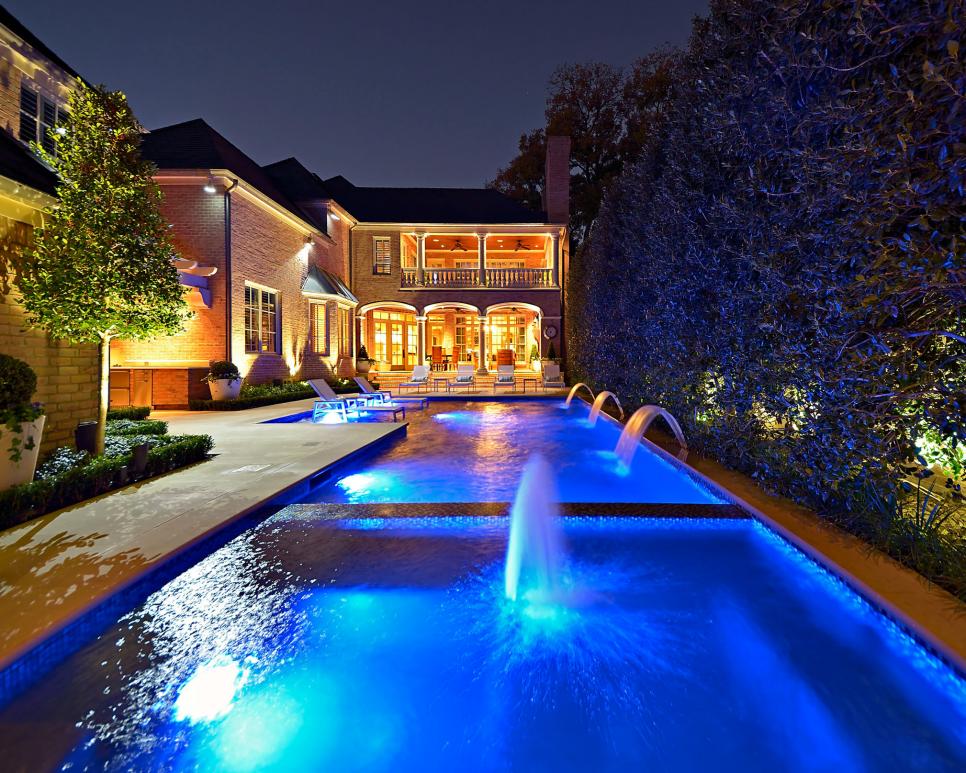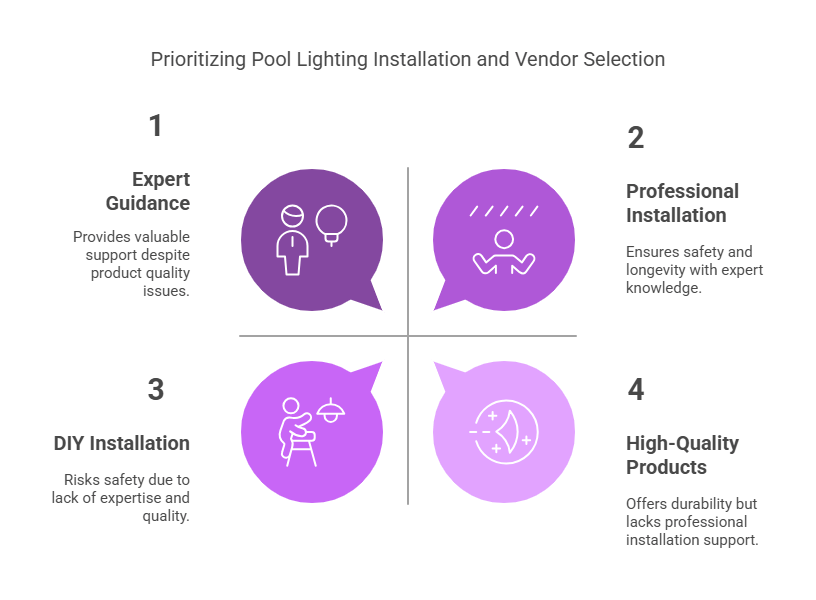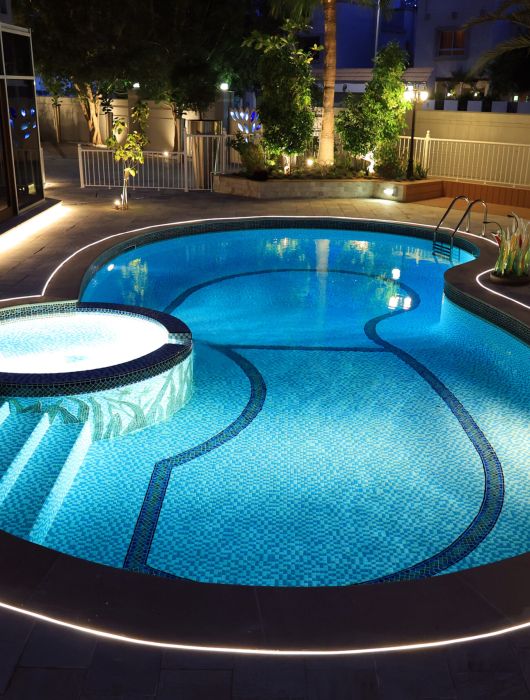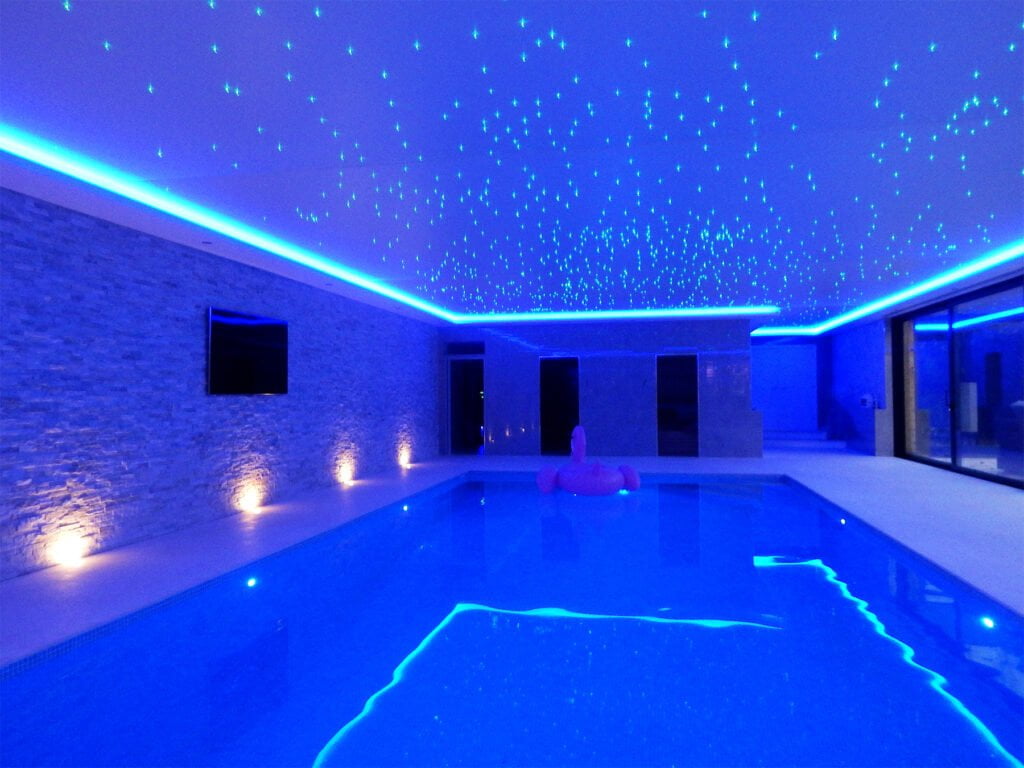Is it Safe to Use LED Lights in a Pool?
Table of Contents
Chilling and recreational moments in swimming pools and spas are enhanced during hot summers. However, the safety of pool lighting remains a concern for many pool owners. When linked to a transformer, energy-saving, low-voltage LED pool lights provide a secure solution.
They outperform incandescent or halogen bulbs regarding energy usage, saving money, and mitigating electrical risks. LED lights, typically operating at 12 volts, connected via wires to a circuit breaker, pose less danger than high-voltage options. They also generate minimal heat, reducing the risk of burns or damage.

Evaluating the Safety of LED Pool Lights
Electrical Safety: Importance of Proper Installation and Maintenance
For the safety of swimmers, it is critical to install LED pool lights, including bulbs and wires, correctly. Installation should be handled by certified electricians with the expertise and understanding to comply with safety standards and handle transformers. Regular maintenance checks also play a key role in averting electrical hazards in the pool area. It’s important to note that LED pool lights, which usually operate at low voltages of around 12 volts, drastically lessen the risk of electrocution compared to conventional lighting options.
Heat Output: Keep Comfortable
LED swimming pool lights stand out due to their minimal heat output and low-voltage lighting. Unlike traditional incandescent or halogen bulbs, LEDs generate very little heat, thanks to their energy-efficient design, promoting electrical safety. This keeps the water temperature comfortable for swimmers and reduces potential risks of overheating or burns from touching hot surfaces. Furthermore, less heat emission and electricity means less wear and tear on surrounding fixtures, contributing to a safer environment with reduced line voltage concerns.
Durability and Longevity: Made to Last
LED pool lights are renowned for their impressive lifespan, significantly outlasting traditional bulb lighting solutions. This long life reduces the need for frequent replacements, thereby lowering potential safety risks linked to faulty electrical systems or incorrect installation during maintenance procedures. Moreover, LED pool lights are designed specifically for wet environments and often come with waterproof casings that protect against water damage – another factor that adds to their durability and overall safety. In addition, these lights have efficient heat dissipation properties, ensuring they remain cool and safe even at line voltage.
Eco-friendly: Lighting Responsibly
When assessing the safety of LED pool lights, their environmental impact and heat dissipation are important factors. These energy-efficient, low-voltage lighting options use less electricity than traditional line voltage alternatives such as incandescent or halogen bulbs – sometimes up to 80% less! By choosing LEDs for your pool area, you reduce electrical hazards and voltage due to their safer design and contribute to a more sustainable future.
Is Pool Lighting Safe?
Compared to traditional lighting options, LED pool lights appear safer. With proper installation and maintenance, electrical safety, low heat output, impressive durability, and eco-friendly features, LED pool lights make for a safer and more enjoyable swimming experience. By ensuring that electrical systems and transformers are functioning well and adhering to safety tips, you can further increase the safety of your pool environment.
However, it is essential to remember that safety isn’t solely determined by the type of light used – factors such as regular maintenance checks, compliance with local regulations, professional installation, and appropriate electrical systems also play significant roles in creating a secure environment for swimmers. By considering these aspects, along with the advantages of low-voltage LED pool lights connected to a transformer, you can create a swimming space that is both safe and welcoming with voltage lighting.

Appreciating the Risk of Electrocution from Pool Lights
Strict Adherence to National Electrical Code
Swimming pool and spa lights are highly sought-after features, adding atmosphere and safety to any pool. Nonetheless, it’s crucial to adhere to the National Electrical Code (NEC) when installing and maintaining these lights, including their wires and bonding. The NEC provides stringent guidelines for swimming pool lighting installations, ensuring safety for swimmers and minimizing the risk of high-voltage electrocution. Compliance with these regulations lets you enjoy your illuminated pool without worrying about potential hazards.
One crucial part of NEC compliance is hiring a licensed electrician familiar with the code requirements for wires, voltage lighting, and voltage lights. This professional will ensure the safe and correct installation of all electrical components, decreasing the likelihood of accidents or malfunctions.
The Danger of Faulty Wiring in Pool Lights
Faulty wiring, which can cause dangerous electrical currents in the water, is a significant concern with swimming pool lighting, particularly underwater and low-voltage lights. If wires are damaged or improperly connected, electricity can leak into the water, posing a severe threat to swimmers. This can sometimes lead to serious injuries or deaths due to electric shock, similar to the dangers associated with street lights.
To avoid such incidents, it’s essential to regularly inspect your swimming pool and spa lights by a licensed electrician who can identify and repair any issues with low-voltage lighting, wires, or connections. Using waterproof fixtures designed for underwater use can help reduce the potential risks of faulty wiring.
LED Pool Lights: A Safer Choice
Compared to low-voltage options like LED pool and spa lights, traditional line voltage lights and their associated wires pose a higher risk of electrocution. LEDs operate at lower voltages than their counterparts – typically 12 volts as opposed to 120 volts – drastically lowering the risk of electric shock in the event of a malfunction, especially with proper bonding.
In addition, low-voltage LED lights use less energy and last longer than traditional high-voltage bulbs, making them a more eco-friendly choice for lighting your pool area. Hence, LED pool lights not only offer enhanced safety features due to reduced wires but also result in cost savings over time due to reduced energy consumption and maintenance requirements.
Regular Inspection and Maintenance by a Licensed Electrician
Securing electrical safety in swimming pools requires more than just installing the right underwater lights. Regular inspection and maintenance by a licensed electrician are crucial to protect your pool area from potential hazards. This professional will check for signs of wear, damage, or malfunction in the electrical system and perform necessary repairs or replacements.
Scheduling regular inspections can help you identify issues before they become severe problems that could pose risks to swimmers. It’s recommended to have your pool lights, wires, and low-voltage and high-voltage systems inspected at least every three years. More frequent checks may be necessary if you notice any signs of trouble or if your pool sees heavy use.
Appropriate Grounding and Bonding: The Cornerstone of Electrical Safety
Grounding and bonding are vital in preventing electric shocks from pool lights. Grounding uses a wire to direct stray electrical currents away from swimmers safely. At the same time, bonding connects all metal components in the pool area to establish an equal potential between them, preventing dangerous voltage gradients that can cause electric shocks.
A licensed electrician will ensure proper grounding and bonding during installation and inspect these connections during routine maintenance visits. By following these guidelines and taking necessary precautions, you can enjoy swimming pool lights’ aesthetic and functional benefits without compromising safety.
Significance of Expert Installation and Selecting a Provider

The Significance of Expert Installation
Safety and longevity take precedence. Professional installation is a vital aspect that guarantees the appropriate use of low-voltage equipment and quality components, enhancing the lifespan of LED pool lighting systems. Industry professionals have the skills and expertise to correctly install low-voltage LED pool lights, mitigating potential hazards such as electrical shorts or water leaks.
For example, experts understand the importance of using suitable waterproof connectors and seals when installing underwater lights, like LED pool lights. These precautions prevent water from entering the light fixture and causing damage or potentially dangerous electrical shocks. Professionals ensure that wiring for all lights is safely routed through conduits, reducing the risk of accidents due to exposed wires. To trust a skilled professional with your LED pool light installation resulting in peace of mind and durable performance.
Choosing a Trustworthy Vendor for High-Quality Goods
Quality pool light products make a significant difference in providing long-lasting illumination in your swimming area, preventing faulty pool issues, and outperforming street lights.
A reliable supplier of swimming pool lighting will provide products made from high-quality materials explicitly designed for use in aquatic environments. For instance, LED swimming pool lights should be UV-resistant to prevent degradation over time due to sun exposure. Moreover, reputable suppliers often offer warranties on their lights, providing you with added confidence in their durability and performance.
By carefully researching LED pool light suppliers before making a purchase, you’ll be better equipped to find one who consistently delivers excellent quality products that significantly contribute to the safety and longevity of your pool lights.
Specialization in Industry: The Crucial Distinguishing Factor
Adding low-voltage LED pool lights to your swimming area enhances safety by improving visibility during nighttime swims and adding visual appeal. However, this balance between aesthetics and practicality requires careful consideration of factors like conduit selection, power transformer sizing, and proper installation support. This is where industry experts play a crucial role in ensuring the safety and longevity of your lighting system.
Experienced professionals understand the importance of using a suitable low-voltage conduit for your pool setup, considering factors like water depth and fixture placement. They can recommend appropriate power transformers based on the total wattage of your LED pool lights, ensuring efficient energy use and preventing potential overloading issues.
Moreover, industry experts provide invaluable support throughout the installation process of LED pool lights by troubleshooting any issues and offering guidance on maintaining your pool lights for optimal performance over time. By enlisting the help of these knowledgeable professionals, you’re investing not only in top-quality products but also in a safe and long-lasting lighting solution for your swimming area.
Exploring the Varieties and Advantages of LED Underwater Lights
Diving Deep into the Diverse World of LED Underwater Lights
Your swimming pool can become a beautiful oasis with the right LED underwater lights. LED lights provide a wide array of options, such as surface-mounted, flush-mounted, and even floating lights, to create the ideal ambiance in your pool area. Depending on your taste, you can create an enchanting, soothing glow or a lively party atmosphere with these versatile LED underwater lights.
Reduce Your Carbon Footprint and Costs with Energy-Efficient LEDs
LED underwater pool lights don’t just save you money on your energy bills – they’re also environmentally friendly. LED lights are considerably more energy-efficient than traditional halogen or incandescent bulbs, using significantly less power and reducing strain on the environment. These long-lasting lights also mean fewer replacements, benefiting your pocket and the planet. So, switch to LED underwater lights – you won’t regret it.
Designed to Endure: Weatherproof and Durable LED Lights
LED underwater pool lights, designed to endure harsh conditions like continuous water exposure and pool chemicals, are low-voltage and waterproof. This ensures their long-lasting performance without compromising on brightness or quality. With these durable LED lights, you can bid farewell to frequent replacements and enjoy their illuminating glow night after night.
Prioritizing Safety: Low-Heat LEDs for Safe Swimming
Enjoy a safe and enjoyable swim with LED underwater lights, which generate considerably less heat than traditional halogen or incandescent bulbs. By reducing the risk of burns and accidents caused by overheated lights, LED lights ensure your swim remains relaxing and safe. Moreover, the low heat output of LEDs also minimizes wear and tear on your pool’s structure and liner, further prolonging their lifespan.
Guidelines for Safe LED Light Installation and Use
Adhere to Industry Standards During Installation
Ensure that you follow industry standards while installing your LED pool lights. This includes using correct wiring, ensuring proper grounding, and following safety guidelines during installation. It would help if you also considered using a certified electrician experienced in pool lighting installations to mitigate potential risks. Always refer to the manufacturer’s instructions for your specific LED pool light model before installing.
Maintain Appropriate Cable Runs and Junction Boxes
Ensure correct cable runs and junction boxes are used when installing your LED pool lights. Adhere to manufacturer recommendations for cable lengths and standard junction boxes for secure connections. Consider installing additional junction boxes if your current setup doesn’t meet these requirements.
Balance Illumination and Heat Output
When choosing LED pool lights, balancing visibility and heat management is important. Opt for low-voltage LED lights that provide adequate illumination without generating too much heat, which can cause damage or create potential hazards. Consider installing several lower-wattage lights instead of one high-wattage light, and choose fixtures designed specifically for underwater use.
Ensure Regular Inspections and Maintenance
Routine inspections and maintenance by a professional electrician or pool technician are crucial for maintaining the safety of your LED pool lights. These checks should include inspecting all cables, connections, and lights, testing for optimal performance, ensuring grounding components are functioning correctly, and checking that all seals on underwater fixtures are intact.
Preventing Electrocution in Swimming Pools: Causes and Solutions
Hidden Hazards: Causes of Pool Electrocution
Swimming pools, while enjoyable, can harbor a potential danger: electrocution. Faulty electrical systems, stray currents, inadequate pool maintenance, and issues with pool lights are all contributors to this serious hazard. Pool owners must be aware of these risks and take necessary preventative measures.
Protecting Lives with Ground Fault Circuit Interrupters
Ground fault circuit interrupters (GFCIs) are vital safety devices for pools, particularly those with lighting features. They prevent possible electrocution by monitoring the electricity flow in a circuit and cutting off power in case of a fault.
Maintaining Your Pool Regularly for Safety
Regular pool maintenance is crucial for cleanliness and safety. Regular checks on electrical connections, signs of wear or corrosion on wiring and equipment, and testing pool lights help prevent electrical hazards.
Preventive Measures for a Safe Swim
Proper installation of electrical systems, including lights, protection against overloads or short circuits with circuit breakers, and regular pool equipment inspection can minimize potential risks.

LED Pool Lights: A Safe and Practical Choice
LED pool lights are safe due to their lower heat output and are cost-effective and eco-friendly. With a long lifespan that reduces the need for frequent replacements and maintenance risks and waterproof materials that ensure durability, LED lights are an excellent choice for pool lighting. Proper installation and regular inspections further ensure safety.
You can enjoy a safe and visually appealing swimming environment by opting for LED pool lights and following safety guidelines for installation and maintenance.

Conclusion
LED pool lights offer a secure, energy-conscious solution to illuminate swimming pools. Their use of low voltage and safety components such as transformers and GFCIs significantly reduces the risk of electrical shocks. Opt for trustworthy suppliers and expert installation services that adhere to industry best practices to guarantee safety. Refrain from DIY installations, as these could potentially jeopardize safety measures. For the best LED pool strip light, Contact MylikeLed today!
FAQs
LED lights designed for pools are made to withstand water exposure and are built with protective enclosures to prevent damage. However, it’s important to use lights rated for underwater use to avoid damage.
No, LED lights in a pool are safe when installed correctly with proper wiring and grounding. Pool-specific LED lights are designed with safety in mind, ensuring there is no risk of electrical hazards.
No, LED pool lights do not affect the water chemistry. They are designed to operate without releasing harmful substances into the pool water, making them safe for both the pool and swimmers.
LED pool lights are known for their long lifespan. They can last up to 50,000 hours or more, making them a cost-effective and durable lighting solution for pools.
Yes, LED pool lights are highly energy-efficient. They use less electricity compared to traditional pool lights, reducing energy consumption and saving you money on utility bills.

Hi, I’m Xylia Xiong, a sales professional with 14 years of experience in the LED strip light industry. I specialize in providing tailored solutions, leveraging my expertise in LED products and the latest industry trends. Known for effective communication and problem-solving, I’m dedicated to helping lighting manufacturers, importers, and distributors achieve their goals.
Let’s work together to create customized solutions that exceed expectations.
Related Posts

The Best LED Strip Lights You Can Buy Right Now

Comparing WS2811 Vs WS2812B: Key Differences


